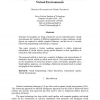Free Online Productivity Tools
i2Speak
i2Symbol
i2OCR
iTex2Img
iWeb2Print
iWeb2Shot
i2Type
iPdf2Split
iPdf2Merge
i2Bopomofo
i2Arabic
i2Style
i2Image
i2PDF
iLatex2Rtf
Sci2ools
VLC
2002
2002
Modeling Behaviors of Interactive Objects for Real-Time Virtual Environments
Real-time 3D graphics are being extensively used to build interactive virtual environments for a number of different applications. In many situations, virtual objects are required to exhibit complex behaviors, and the use of a versatile behavioral programming methodology is required. This paper presents a feature modeling approach to define behavioral information of virtual objects, giving special attention to their capabilities of interaction with virtual human actors. The proposed method is based on a complete definition and representation of interactive objects, which are called smart objects. This representation is based on the description of interaction features: parts, movements, graspable sites, functionalities, purposes, etc, including a behavioral automata based on scripts and graphical state machines.
| Added | 23 Dec 2010 |
| Updated | 23 Dec 2010 |
| Type | Journal |
| Year | 2002 |
| Where | VLC |
| Authors | Marcelo Kallmann, Daniel Thalmann |
Comments (0)

